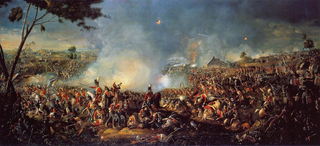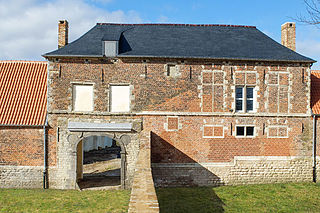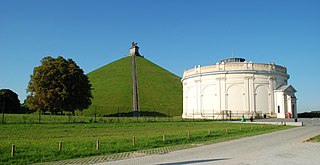
The Battle of Waterloo was fought on Sunday, 18 June 1815, near Waterloo in Belgium, part of the United Kingdom of the Netherlands at the time. A French army under the command of Napoleon Bonaparte was defeated by two of the armies of the Seventh Coalition, a British-led coalition consisting of units from the United Kingdom, the Netherlands, Hanover, Brunswick, and Nassau, under the command of the Duke of Wellington, referred to by many authors as the Anglo-allied army or Wellington's army, and a Prussian army under the command of Field Marshal von Blücher, referred to also as Blücher's army. The battle marked the end of the Napoleonic Wars. The battle was contemporaneously known as the Battle of Mont Saint-Jean or La Belle Alliance.

Waterloo is a 1970 epic period war film directed by Sergei Bondarchuk and produced by Dino De Laurentiis. It depicts the story of the preliminary events and the Battle of Waterloo and is famous for its lavish battle scenes. It was a co-production between the Soviet Union and Italy, and was filmed in Ukraine.

Château d'Hougoumont is a walled farm compound, situated at the bottom of an escarpment near the Nivelles road in the Braine-l'Alleud municipality, near Waterloo, Belgium. The site served as one of the advanced defensible positions of the Anglo-allied army under the Duke of Wellington, that faced Napoleon's Army at the Battle of Waterloo on 18 June 1815.

The Battle of Quatre Bras was fought on 16 June 1815, as a preliminary engagement to the decisive Battle of Waterloo that occurred two days later. The battle took place near the strategic crossroads of Quatre Bras and was contested between elements of the Duke of Wellington's Anglo-allied army and the left wing of Napoleon Bonaparte's French Armée du Nord under Marshal Michel Ney. While the battle was a coalition victory, Napoleon prevented Wellington's forces from aiding the Prussian army at the Battle of Ligny, which the French won the same day.

Quatre Bras is a hamlet in the municipality of Genappe, Wallonia, Belgium. It lies on the crossroad of the Charleroi-Brussels road and the Nivelles-Namur road south of Genappe.

Brussels Cemetery is a cemetery situated in Evere, Brussels (Belgium). Located in the neighbouring municipality of Evere, rather than in the City of Brussels proper, it is adjacent to Schaerbeek Cemetery and Evere Cemetery, but should not be confused with either.

Ligny is a village of Wallonia and a district of the municipality of Sombreffe, located in the province of Namur, Belgium.

Wellington's Column, or the Waterloo Memorial, is a monument to the Duke of Wellington standing on the corner of William Brown Street and Lime Street, Liverpool, Merseyside, England. It is recorded in the National Heritage List for England as a designated Grade II* listed building.

Charles Angélique François Huchet, Comte de la Bédoyère was a French General during the reign of Emperor Napoleon I who was executed in 1815.

The Lion's Mound is a large conical artificial hill located in Wallonia in the municipality of Braine-l'Alleud, Belgium. King William I of the Netherlands ordered its construction in 1820, and it was completed in 1826. It commemorates the location on the battlefield of Waterloo where a musket ball hit the shoulder of William II of the Netherlands and knocked him from his horse during the battle. It is also a memorial of the Battle of Quatre Bras, which had been fought two days earlier, on 16 June 1815.

The following units and commanders fought in the Battle of Quatre Bras on 16 June 1815 at Quatre Bras in the Belgian province of Wallonia. The numbers following each unit are the approximate strengths of that unit.

James Hay, Lord Hay and Lord Slains was a British Army officer killed during the Waterloo Campaign.

The Column of the Grande Armée is a 53 metre high Corinthian order triumphal column on the Rue Napoleon in Wimille, near Boulogne-sur-Mer, France.
The Brigade van Bylandt was a Dutch infantry brigade led by major general Willem Frederik Graaf van Bylandt which fought in the Waterloo Campaign (1815).
The Belgian 7th Line Infantry Battalion was a Belgian/Southern Netherlands regular (line) battalion commanded by lieutenant-kolonel F.C. van den Sande which fought with distinction during the Waterloo Campaign of 1815.

The belfry of Mons is one of the more recent among the belfries of Belgium and France. This belfry, classified in Belgium since 15 January 1936, belongs to the major cultural patrimony of Wallonia. It was inscribed on the UNESCO World Heritage List on 1 December 1999, for its unique architecture, civic importance, and testimony to the birth of municipal influence and power in the area. It is the only one in Belgium that is constructed in baroque style. At a height of 87 meters, it dominates the city of Mons, which is constructed on a hill itself.

The Panorama of the Battle of Waterloo is a rotunda in Belgium that houses a monumental panoramic painting depicting the Battle of Waterloo. The neoclassical building is located immediately to the north of the Lion's Mound on the battlefield of the Battle of Waterloo in the municipality of Braine-l'Alleud in the Belgian province of Walloon Brabant.

Brye is a village of Wallonia and a district of the municipality of Fleurus, located in the province of Hainaut, arrondissement of Charleroi, Belgium. Its post code is 6222, and telephone zone code is 071.

The Memorial of Waterloo 1815 is a Belgian museum complex located on the site of the Waterloo battlefield in Belgium. It includes a museum inaugurated in 2015, the Lion's Mound, the Panorama of the Battle of Waterloo and the Hougoumont farm.





















